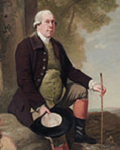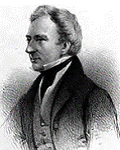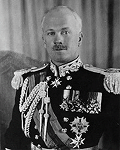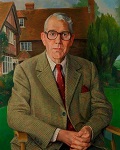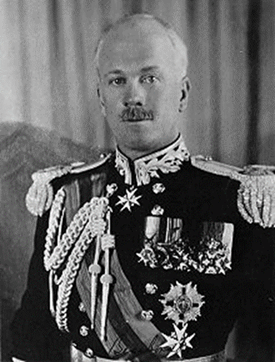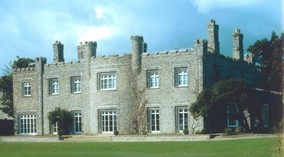Landed Gentry
One notable feature of the Rowlands Castle area is the existence of three large country estates – Stansted, Idsworth and Staunton – each with its own interesting history. This article focuses on the owners of these estates over the centuries. The history of the houses is described in Large Houses and the features of each land estate can be found in the Three Estates.
References to the Landed Gentry can be found in local churches and graveyards. They contributed to the local community by offering land for the current Recreation Ground, the Parish Hall, and also for funding local schools. Older residents still have warm recollections of annual visits to their ancestral homes (listen to Sonya Teale’s audio tapes).
Idsworth
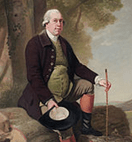
Sir Jervoise Clarke-Jervoise, 2nd Bart
The Clarke Jervoise family, comprising seven hereditary baronets – from 1770 to 1933 – owned the estate until it was sold off in 1974 following the death of Major Arthur Clarke Jervoise (1882-1974).
The estate has a much longer history going back to Norman times, but since the early 1800s Idsworth’s history relates to the baronets of the Clarke-Jervoise family. Originally, the estate was centred on a house and grounds close to St Hubert’s Chapel on the eastern bank of the eastern Lavant. During the 1860s, however, it was relocated westwards, to a plateau across the valley, to distance it from the railway line then being built to link London to Portsmouth. The original house was demolished but significant features remain including a fine large barn, a walled garden and a deteriorating avenue of lime trees running up the opposite hillside. The new mansion was built by Sir Jervoise Clarke-Jervoise on the plateau to the west of Finchdean.
Clarke-Jervoise: Owners of Idsworth
| 1 | Rev Sir Samuel Clarke-Jervoise, 1st Bart | 1770-1853 | Age 73 | Corpus Christi, Oxon | MP 7 times |
| 2 | Sir Jervoise Clarke-Jervoise, 2nd Bart | 1804-1889 | 85 | MP 7 times 1768-1808 | |
| 3 | Sir Arthur Henry Clarke-Jervoise, 3rd Bart | 1856-1902 | 46 | Eton; Coldstream Guards | |
| 4 | Lieutenant-Colonel Sir Henry Clarke-Jervoise, 4th Bart | 1831-1908 | 77 | Coldstream Guards | |
| 5 | Sir Harry Samuel Cumming Clarke-Jervoise, 5th Bart | 1832-1911 | 79 | Harrow; Merton College, Oxon | |
| 6 | Sir Eustace James Clarke-Jervoise, 6th Bart | 1870-1916 | 46 | ||
| 7 | Sir Dudley Alan Lestock Clarke-Jervoise, 7th Bart | 1876-1933 | 57 | ||
| 8 | Major Arthur Francis Clarke-Jervoise | 1882-1974 | 92 |
Former resident Guy Phelps – who until recently lived in the Idsworth hamlet formed in the outbuildings of the current House – has written a helpful article about the family: Idsworth: ‘The Rise and Fall of the Clarke-Jervoise Dynasty’
Editorial: Unlike the Earls of Bessborough at Stansted and Sir George Staunton at Staunton Park, there are relatively few documented references describing the Clarke-Jervoise family. RCHC is interested to learn more about the family. If you can help, please write to the Editor.
Staunton Park
Sir George Thomas Staunton – Henry Stone – General Sir Fitzwygram
In 1820, at the age of forty, Sir George Thomas Staunton (1781-1859) purchased the original mansion and estate from George Arkell, a Portsmouth man. In 1861, the estate was bought by the second significant owner – William Stone MP (1834-1896). He built a new Victorian mansion on the plateau overlooking the lake. In 1875, however, the estate was bought by General Sir Frederick Fitzwygram, succeeded by two generations of his family.
Staunton Estate and its owners are comprehensively described by Derek Gladwyn in his history “Leigh Park – a 19th Century Pleasure Ground”, published in 1992 by Middleton Press. It describes Sir George Thomas Staunton, 2nd Baronet (1789-1859) in considerable detail as the most influential of the three main owners.
A shorter publication has also been written for The Spring (Havant) Museum.

Sir George Thomas Staunton, 2nd Baronet
When George Thomas Staunton bought the house and estate in 1820 he was nearly 40 years old, well established in life and society, having already served as an MP. When redeveloping the estate, his wide experiences of travelling to the Far East influenced his outlook. But, importantly, much of George Thomas’s early development can be attributed to his father, Sir George Leonard Staunton (1st Baronet) who gave his son a flying start in life.
In addition to an unusual education, delivered by domestic tutors with a focus on languages, George Thomas also went to Trinity College but was withdrawn after two terms! His father’s main influence, however, included taking him on diplomatic missions to the Emperor of China, enduring long voyages to the Far East.
George Leonard’s background shows that he was born in 1737 in County Galway. In 1753, for health reasons, and at the age of sixteen he was sent to the south of France for education and university where he gained a degree in Medicine. In 1760 he returned to London then shortly went on to Grenada in the West Indies where he practised as a doctor. In 1771, however, he came back to London again, and married Jane Collins (daughter of a bookseller, publisher, and banker). Returning to Grenada, they had two children, both dying in infancy.
By way of a further digression, Lord George Macartney, 1st Earl, who was George Leonard’s friend, was appointed in 1776 as the Governor of Grenada (they were the same age and with different but compatible personalities). Meanwhile George Leonard had also qualified in Law, and in 1779 was awaiting appointment as Attorney General for Grenada. (That same year Grenada was captured by the French and who returned them both to France. Apparently, George Leonard negotiated an exchange for both himself and Lord Macartney). Subsequently, Lord Macartney – who had already established a reputation as a diplomat after a successful mission to Catherine II of Russia – was appointed Governor of Madras and was accompanied by George Leonard as Private Secretary.
When George Leonard next returned to England after the birth of his son (George Thomas), he pursued those intellectual pursuits that had interested him previously. Sir George Leonard was a Fellow of the Royal Society (1787) and The Linnean Society (1789). In 1790 he was awarded an honorary Doctor of Civil Law by Oxford University. He was a friend of Sir Joseph Banks (1743-1820) the botanist and Edmund Burke (1729-1797). He was also preoccupied with his son’s education – unusually by tutors – including attending meetings of learned societies.
In 1791, George Leonard prepared for the voyage to China as part of an Embassy to meet the Emperor. One of his immediate tasks was to hire two tutors in Naples, to teach Chinese to his son. When his close friend, Lord Macartney was appointed as the Ambassador, George Leonard became Secretary (with authority to take over if Lord Macartney died). George Thomas went too, with the title of ‘Page’. The voyage to India and beyond to China was long in a small flotilla of sailing ships including HMS Lion. While the outcome of the mission did not result in specific trade deals, it was adjudged successful – particularly by developing George Thomas as a Chinese linguist and expert in Chinese law. His father also gained distinction by documenting the mission. The mission also allowed the study of plant biology too. These experiences of a lifetime accompanying his father, provided an immense influence over the development of George Thomas.
On his father’s death in 1801, George Thomas succeeded him as 2nd Baronet. However he did not learn of his father’s death until seven months later as he had gone on a second visit to China, employed as a Junior Clerk by the East India company (EIC). After his fifth visit to China, he decided to withdraw from the Far East, having also transferred his attention to the collection of exotic plants.
When purchasing the estate in Leigh Park (now part of the neighbouring Borough of Havant) Sir George Thomas Staunton re-developed it as a ‘Victorian Pleasure Ground’ – a fashion in vogue at the time. The local road was diverted away from the House (when the current ‘Middle Park Way’ was only a track). Much of the landscaping including lakes and woodlands also had numerous features reminiscent of his Chinese adventures. There were fine glass houses, and a number of follies. In recent decades those that endured have been restored to remind us of the ‘Pleasure Ground’.
William Henry Stone MP (1834-1896) eventually bought the estate for £60,000 in 1861, two years after George Thomas’ death. William Stone, then aged 27, replaced the original house with a larger Victorian Mansion overlooking the lake, with a purpose-built stable block nearby.
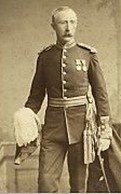
Lieutenant-General Sir Frederick Fitzwygram (1823 – 1904) bought the estate in 1875. He was distantly related to Sir George Tomas Staunton. The estate was retained largely as developed by the two earlier longer-term owners. It passed to his daughter Angela on the death of his son in 1920. Some of the estate was sold between the Wars by Angela.
Most of the remaining estate was requisitioned during World War II, and subsequently purchased by Portsmouth City Council for local housing. The northern part, however, became a Country Park in multiple landownerships, but administered ultimately by Hampshire County Council (who now manage it jointly with the nearby Queen Elizabeth Country Park).
Owners of Staunton Park
| 1 | Sir George Thomas Staunton, 2nd Bart | 1781- 1859 | Age 78 | *Purchased Leigh Park Gardens in 1820 MP Six times | |
| 2 | William Henry Stone | 1834 – 1896 | 62 | Harrow; Trinity College, Cambridge: Made Fellow 1859 | *Purchased Estate in 1861 Built new Victorian House 1865 |
| 3 | Lieutenant-General Sir Frederick John Fitzwygram | 1823 – 1904 | 81 | Eton; FRCVS; MP twice | *Purchased Estate in 1875 |
Editorial: A pamphlet about Lieutenant-General Fitzwygram has been published by The Spring Museum, Havant
Stansted Estate: Earls of Bessborough
The Earls of Bessborough: owners of Stansted Park
Stansted is the third estate referred to in this topic about ‘landed gentry’. It should be clarified, however, that although having a Rowlands Castle postcode, PO9 6DX, it lies wholly within the adjoining County of West Sussex. The Estate comes very close to the railway line at the centre of Rowlands Castle Village (Hampshire). Historically it has employed local people and is now of prime recreational and walking interest to many villagers and visitors.
The last family to own Stansted Park Estate were the Ponsonbys, Earls of Bessborough, originally an Irish peerage. Vere Brabazon Ponsonby, the 9th Earl (1880-1956), purchased the estate in 1924. When Vere succeeded to the earldom, his son Frederick Neuflize Ponsonby (1913-1993) became Viscount Duncannon (also an Irish peerage).
On the death of Vere his father, Frederick became the 10th Earl and inherited the estate. But in 1983, Frederick transferred ownership of the estate to the Stansted Park Foundation – a registered charity. Frederick, however, maintained an interest in the estate as a Trustee of the newly formed charitable foundation.
Frederick had no male heirs and on his passing in 1993 the title was inherited by Arthur Mountifort Longfield Ponsonby, Frederick’s cousin. They were both grandchildren of Edward Ponsonby (1851-1920), 8th Earl of Bessborough.
Arthur’s son, Myles Fitzhugh Longfield Ponsonby, succeeded his father in 2002. Myles, although not the owner of the Estate, has again continued to maintain a family interest as a Trustee and one time Chairman of Trustees of the charity. He lives on a farm adjacent to the Estate. In 2020, with the advice of his son-in-law, the Mansion was refurbished, interpreting family history and incorporating previous historic family memorabilia – medals and swords – inherited from Victorian times.
(Editorial: While the estate is open throughout the year, the Mansion itself is only open from Easter until the end of September.)
Backgrounds of Earls associated with Stansted Park
| 1 | Vere Brabazon Ponsonby, 9th Earl | 1880- 1956 | 76 | Harrow School Trinity College, Cambridge Inner Temple 1903 | MP twice | * Purchased Stansted Park 1924 |
| 2 | Frederick Neuflize Ponsonby, 10th Earl | 1913- 1993 | 80 | Eton College Trinity College, Cambridge | MP twice | *Succeeded in 1956 *Made over to Stansted Park Foundation in 1983 |
| 3 | Arthur Mountiford Longfield Ponsonby, 11th Earl | 1912-2002 | 90 | Harrow School Trinity College, Cambridge | *Welsh Guards | |
| 4 | Myles Fitzhugh Longfield Ponsonby, 12th Earl | 1941- | Harrow School Trinity College, Cambridge | FICA |
The chart, above, shows the education and some public service of the Earls. It is intended that subsequent research should describe the families’ wider role in the community, including as benefactors.
Careers of the Earls of Bessborough
As noted, Vere, 9th Earl of Bessborough purchased the Stansted Estate in 1924. (The mansion had been rebuilt following a serious fire in 1900.) Vere had a distinguished career, serving in the army during World War I. He was a member of the London County Council before being elected as a Member of Parliament of the UK House of Commons in 1910, representing Cheltenham.
Vere was appointed Governor General of Canada from 1931 until 1935. Two years later in 1937, he was created the 1st Earl of Bessborough as an English Earldom, from which time he sat in the UK House of Lords. (It should be remembered that Ireland had seceded from the United Kingdom after ‘the troubles’ in 1922 under the Anglo-Irish Treaty, thus becoming the Irish Free State.)
Vere was succeeded in 1956 by his son Frederick Ponsonby, the 10th Earl of Bessborough, still an English peerage. Frederick had also been a member of the UK House of Commons. He worked for the League of Nations, served briefly in World War II including in the Army during Dunkirk. From 1944-48, he held a diplomatic role at the British Embassy in Paris. Following the United Kingdom’s accession to the European Union, he was appointed as one of the first English Members (MEPS), serving as the first Vice-President of the European Council. He subsequently sat in the UK House of Lords and held ministerial appointments. Like his father, he was interested in drama and the arts, and became a founder member, and then Chairman, of the Chichester Festival Theatre Trust. Overall, both he and his father had most illustrious careers.
Frederick was obviously delighted to live on the Stansted Estate as he wrote three books:
- ‘A Place in the Forest being the Story of Stansted in Sussex’, 1958
- ‘Return to the Forest’, an autobiography, 1962
- ‘Enchanted Forest, The Story of Stansted in Sussex’, 1984
(Editorial: the books can normally be purchased at Stansted House, when it is open during the summer season)
As already noted, in 1983 Frederick transferred the estate to a charitable trust – the Stansted Park Foundation – to protect the estate for the future and committing to open it to members of the public. Frederick died in 1993.
As Frederick had no male heirs, the English Earldom became extinct. The Irish Earldom, however, continued in existence so his cousin Arthur Mountifort Longford Ponsonby became the 11th Earl. (The family connection was that both Frederick and Arthur were grandsons of Edward Ponsonby, 7th Earl of Bessborough.) By the time of Arthur’s accession to the Irish title, the Stansted Park Foundation had been the formal owner of the estate for ten years.
Arthur was succeeded in 2002 by his son Myles Ponsonby who became the 12th Earl. Myles lives in a farm adjacent to the Estate, and maintains a strong family interest, serving as Chairman of the Stansted Park Foundation. Myles’ son, Frederick Arthur William Ponsonby, born in 1974, has the title of Viscount Duncannon. He is also a trustee of the charity.
It might also be noted that Myles Ponsonby has the title of Baron Sysonby of Wonersh (in the County of Surrey). This is an English peerage, and until legislation in 1999, the Baron would have had a seat in the House of Lords.
The Stansted Park Foundation – a registered charity – has been the formal owner of the estate since 1983. It invites support in a variety of ways on its website.
(A complete Stansted Park Timeline was provided courtesy of the former Director of the Estate).
Origins of the Title – Earl of Bessborough
The early history of the Ponsonby family and its connection with the Irish peerage goes back to 1652. At this time John Ponsonby (1608 -1678), from Haile Hall (also spelt Hale Hall) in Cumberland, arrived in Ireland with a small troop of men in 1641 at the start of the English Civil War (1642-1651). He assisted Oliver Cromwell – activist Parliamentarian, politician and soldier – who ultimately became Lord Protector of the Commonwealth of England, Scotland and Ireland. Cromwell was intent on subduing Ireland as part of the British Commonwealth.
At the end of the Civil War, the loyalty of John Ponsonby was recognised when he was created a baronet. He was also awarded land at Kildalton, County Kilkenny, which he renamed Bessborough – the maiden name of his wife, Elizabeth. He represented Kilkenny in the Irish House of Commons from 1661 to 1666. His son William, born in 1669, was later appointed Viscount Duncannon, again sitting in the Irish House of Commons.
It was his grandson Brabazon Ponsonby (1679-1758) who in 1739 became the first Earl of Bessborough. From 1705-1757, he was an active politician in Great Britain and Ireland, sitting in the Irish House of Commons.
The Ponsonby family went on to become one of the most powerful political families in Ireland in the eighteenth century, when in 1743 John Ponsonby married Elizabeth Cavendish, daughter of the 3rd Duke of Devonshire. The family continued its involvement in national life and achieved high office during the reign of Queen Victoria, including the opportunities provided by the then British Empire.
(Editorial: In the United Kingdom there is a five-fold hierarchy of titles which have evolved throughout the centuries, and sometimes reflect the main cultures of their time:
Duke Duchess
Marquess Marchioness
Earl Countess
Viscount Viscountess
Baron Baroness
Baronet a rank below the hereditary ranks of the five peerages
Southleigh House and Estate
Sir Rudolph Dymoke White (1888-1968), 2nd Baronet
By way of a postscript, it should be mentioned that there is also a fourth mansion at Southleigh Estate – being mostly south of the Rowlands Castle Parish boundary. There are two tracts of land within the Parish – one now developed as a Spire Hospital, and the other as a large landfill site (now in process of restoration to woodland). Geographically, this fourth estate also links or bridges between the Staunton Estate to the west, and Stansted Estate to the East.
Southleigh House (now in Havant Borough) is a fine mid-Victorian construction and a Grade II listed building. The grounds have been designated as a Special Area of Conservation. The site has been redeveloped for offices and industry. Unlike Staunton Park or Stansted, however, it is not open to the public.
As this chapter focuses on Landed Gentry, Sir Rudolph Dymoke White was an owner of the site. He was a local politician who represented Fareham constituency in Parliament from 1939 until 1950.
Dymoke’s son was Lieutenant Colonel Sir Lynton Stuart White (1916-2005), 3rd Baronet, who subsequently lived in Woodbrook, East Meon. He was educated at Harrow School, then Trinity College Cambridge. Following distinguished military service, he was elected and re-elected to Hampshire County Council from 1970 to 1984, serving as Chairman of the Council for the last seven years. He represented the Catherington Division which then included the three parishes of Rowlands Castle, Clanfield and Horndean.
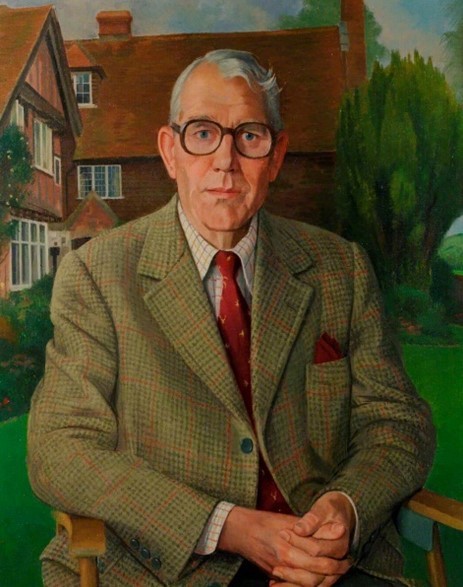 Sir Lynton White (HCC Art Gallery)
Sir Lynton White (HCC Art Gallery)
Conclusions about Landed Gentry from Rowlands Castle area
The Landed Gentry associated with the Three Estates over the past two hundred years – the fifteen individuals mentioned above – collectively endured the Industrial Revolution, the ‘British Empire’, two World Wars and the beginning of the 21st century. It is striking how much they were involved in public service, with at least six of them being elected to Parliament (United Kingdom or Ireland), usually for more than one election. Two of the Earls sat in the House of Lords, one holding ministerial appointments. In keeping with the time, several were appointed Governors or Governor Generals in the British Empire. Locally some served as Lord Lieutenants of their respective Counties, particularly Hampshire, Sussex or Surrey.
By way of summary their backgrounds focus on:
* most of them were hereditary Earls or Baronets
* they usually owned a home in London, and sometimes other large estates
* most went to the best two English schools – Eton or Harrow
* most went on to university, particularly Trinity College, Cambridge
– military service appears as an alternative to university
* importantly, most engaged in public service as members of Parliament
* some were recognised further as Governors, or Lord Lieutenants
* many were also public benefactors – of land, funds, or important activities
